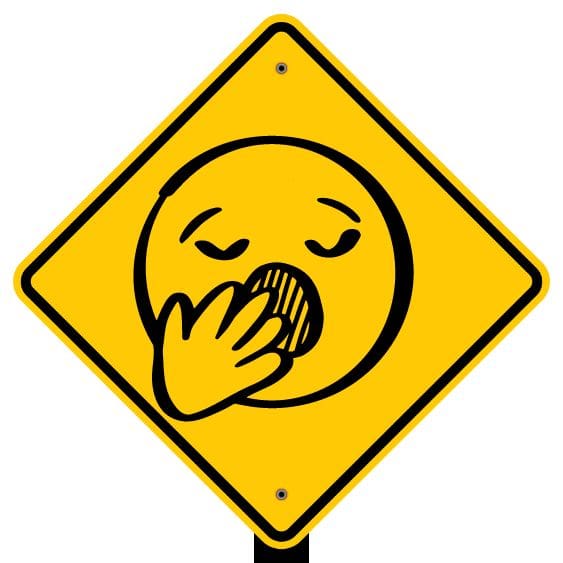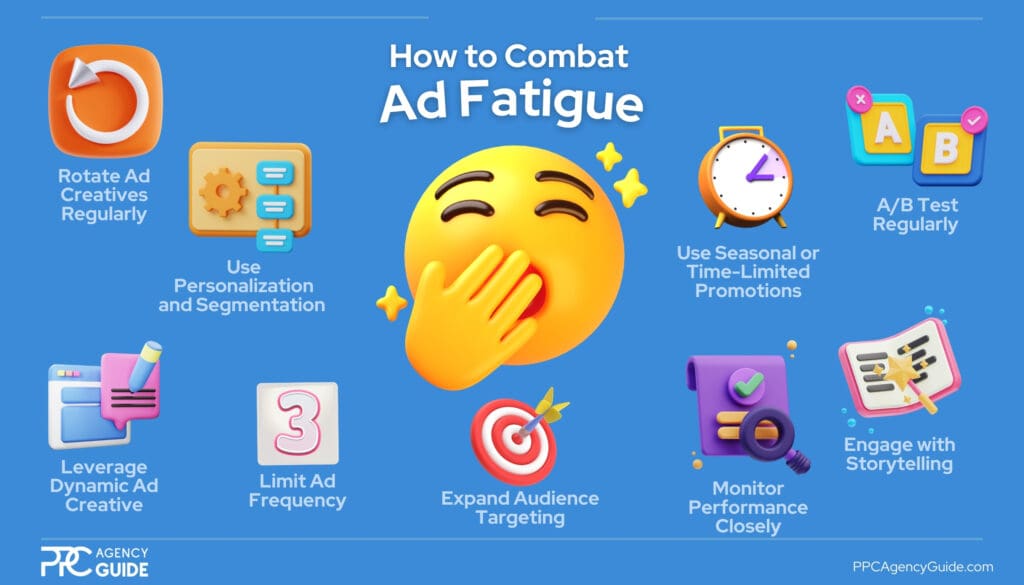
You’ve crafted the perfect ad, launched it with confidence, and watched as the clicks poured in. But now, just a few weeks later, the results have flatlined. Sound familiar? What you’re experiencing is ad fatigue—and it’s more common than you think. On this page, we’ll walk you through how to identify if your campaigns are creating ad fatigue and go over ad fatigue strategies to breathe new life into ads.
Ad Fatigue Explained
Ad fatigue occurs when your target audience becomes overly familiar with your ads, resulting in diminishing engagement and effectiveness. Essentially, people get tired of seeing the same ad repeatedly, and this leads to them ignoring or even developing negative feelings toward the ad.
Signs Your Ads Are Causing Ad Fatigue
There are several signs your business might be suffering from ad fatigue.

- Declining Click-Through Rates (CTRs): If fewer people are clicking on your ads despite consistent or increasing impressions, it’s a red flag. For instance, CTR drops by around 30 percent when people see your Facebook ads five times, per AdEspresso. When people see an ad nine times, the CTR drops by 50 percent.
- Lower Engagement: For platforms where likes, shares, or comments are tracked, you’ll see a noticeable drop in these interactions as ad fatigue sets in.
- Higher Cost-per-Click (CPC): When ads stop resonating with audiences, platforms like Google or Facebook will charge more to get the same visibility. For instance, CPC jumps around 99 percent when a Facebook ad is seen five times, per AdEspresso. When people see it nine times, CPC skyrockets by 161 percent.
- Conversion Rate Drop: Even if your ad is still getting clicks, the number of people actually completing the desired action—whether that’s making a purchase or signing up—will decrease.
Impact of Ad Fatigue on Campaign Performance
The impacts of ad fatigue on performance can be significant.
- Wasted Ad Spend: You’ll be spending the same or more money for less return. This leads to inefficient campaigns that hurt your overall ROI.
- Audience Disengagement: When people are repeatedly exposed to the same ads, they begin to ignore them, making it harder to recapture their attention, even with future campaigns.
- Brand Negativity: If your ads are overexposed and unvaried, they can create a negative association with your brand, leading to a loss of trust or interest in your product or service.
Causes of Ad Fatigue
The causes of ad fatigue can vary, but they often boil down to a few common factors. We’ll identify fatigue triggers below.
Overexposure to the Same Creative
This is the most obvious cause. When a single ad or set of ads is shown too many times, people naturally lose interest. This is especially common in platforms like Facebook or Google Display Network, where the frequency of ad views can skyrocket if the audience is too small or the creative doesn’t rotate frequently.
Lack of Audience Segmentation
If you’re showing the same ad to all segments of your audience without considering audience preferences, unique interests, pain points, or stage in the buyer’s journey, the message can become stale. For instance, showing a product awareness ad to repeat customers won’t resonate and could even frustrate them.
Creative Stagnation
Sometimes, businesses create ads that were successful initially but fail to refresh the content as time goes on. Even if an ad performed well for the first few weeks, running it indefinitely without tweaking the messaging, imagery, or offer will eventually lead to fatigue.
Excessive Ad Frequency
Platforms like Facebook and Instagram provide metrics such as ad frequency, which shows how many times an ad has been shown to the same individual. When this number gets too high—usually above three or four views per person—the effectiveness drops sharply.
Seasonal or Time-Sensitive Ads
Ads tied to specific events or seasons can become irrelevant if they run too long. For example, a holiday sale ad running in January is not only irrelevant but might annoy the audience who have moved on from that event.
Strategies to Combat Ad Fatigue
To combat ad fatigue effectively, businesses need to apply a combination of strategies that keep their ads fresh, relevant, and engaging for their target audience. Here are some approaches that can help mitigate the effects of ad fatigue.

Rotate Ad Creatives Regularly
Refreshing your creative elements is one of the most straightforward ways to combat ad fatigue. This involves changing up visuals, messaging, and calls-to-action (CTAs). A general rule is to update your ads every two to three weeks, depending on the platform. You could experiment with different formats—static images, videos, or carousel ads—to keep things dynamic.
Use Audience Personalization and Segmentation Techniques
By creating targeted campaigns for different audience segments, you can tailor your messaging to be more relevant to each group. This makes the ad feel fresh, even if someone has seen another version of it. Segmentation based on factors like location, behavior, and purchase history helps deliver the right message at the right time.
Leverage Dynamic Ad Creative
Platforms like Facebook and Google offer dynamic ad options, where multiple versions of headlines, images, and descriptions are rotated automatically. This ensures users don’t see the exact same ad repeatedly, as the platform varies the elements to keep things fresh.
Limit Ad Frequency
Keep an eye on the frequency metric, which measures how many times a user has seen the same ad. If your frequency is climbing, generally above three to four times per user, it’s time to rotate the ad or cap the frequency. Most platforms allow you to set frequency limits, which can help avoid oversaturating your audience.
Expand Your Audience Targeting
If you’re targeting a small audience and showing them the same ad repeatedly, it’s likely that fatigue will set in quickly. Expanding your audience or using lookalike audiences can help by ensuring more people see your ads and reducing repetition.
A/B Test Regularly
Testing different ad variations helps identify which ones resonate with your audience. By running multiple versions of an ad and seeing which performs better, you can keep the most effective creatives in rotation while discarding those that start showing signs of fatigue.
Use Seasonal or Time-Limited Promotions
Running short, time-sensitive campaigns—like flash sales or holiday promotions—can help prevent ad fatigue because these ads naturally rotate out when the promotion ends. Just be mindful not to let these linger too long beyond their relevance.
Engage with Storytelling
Building a narrative across multiple ad formats can keep your audience intrigued. Instead of showing the same message repeatedly, use a series of ads that tell a story, revealing a little more each time. This can keep users engaged over longer periods.
Monitor Performance Closely
Use analytics tools to keep a close eye on key performance indicators like CTR, conversion rates, and frequency. If you see sudden drops, it’s likely that ad fatigue is setting in, and you can act quickly by refreshing the creatives or targeting.
Get Help Eliminating Ad Fatigue
Whether you’re trying to thwart existing ad fatigue or improve content diversity and ad creativity to prevent it from happening, it helps to have an experienced PPC agency on your side. To get matched with an agency that can keep your audience engaged and clicking, request a complimentary consultation.
FAQs on Ad Fatigue and Ad Fatigue Strategies
How can I tell if my ads are suffering from ad fatigue?
Signs of ad fatigue include a drop in CTR, declining engagement, rising CPC, and lower conversion rates. If you notice that your ad's performance is steadily decreasing despite stable impressions, it could indicate that the audience has grown tired of the creative.
What are the signs of ad fatigue in social media advertising?
Key signs of ad fatigue on social media include fewer likes, shares, or comments, a decline in CTR, and higher costs to maintain ad visibility. If your audience repeatedly sees the same ad, you may notice disengagement or even negative reactions in comments, which could harm brand perception.
How often should I refresh my ad creatives to prevent ad fatigue?
Refreshing ad creatives every two to three weeks helps maintain engagement. However, the exact timing depends on your ad frequency and audience size. Regularly updating visuals, copy, and offers ensures that your ads stay fresh, preventing audience boredom and fatigue.
What is a good ad frequency to avoid ad fatigue?
A frequency of three to four impressions per user is often ideal to avoid ad fatigue. After this, performance metrics like CTR typically decline. Monitoring ad frequency metrics on platforms like Facebook and Google allows you to adjust campaigns before fatigue sets in.
Can targeting a smaller audience cause ad fatigue?
Yes, targeting a small audience can quickly lead to ad fatigue because the same people are exposed to your ads repeatedly. To prevent this, expand your audience or segment it into different groups, each receiving tailored ads to avoid overexposure.
How does ad fatigue impact click-through rates (CTR) and conversions?
Ad fatigue causes CTR and conversion rates to drop as users become tired of seeing the same ad. Once your audience stops engaging with the creative, your costs per click increase, and fewer people complete the desired action, reducing overall campaign effectiveness.
What strategies can I use to combat ad fatigue in Facebook ads?
To combat ad fatigue on Facebook, rotate creatives every two to three weeks, segment your audience, use dynamic ad creative, and A/B test to identify what resonates. Limiting ad frequency and expanding your audience can also help reduce overexposure.
How does audience segmentation help reduce ad fatigue?
Audience segmentation reduces ad fatigue by delivering personalized, relevant ads to specific groups. Instead of showing the same ad to everyone, you can tailor the message, creative, and offer based on the audience's needs and preferences, keeping your ads fresh and engaging.
Is dynamic ad creative effective in preventing ad fatigue?
Yes, dynamic ad creative allows platforms like Facebook and Google to mix and match different headlines, images, and CTAs, ensuring that users don’t see the same ad repeatedly. This keeps your ads varied, reducing the likelihood of ad fatigue while optimizing performance.

















